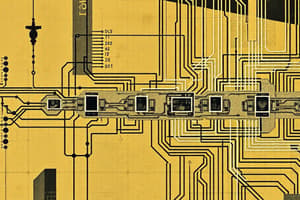Podcast
Questions and Answers
What type of gate is a transmission gate (TG)?
What type of gate is a transmission gate (TG)?
- A logic gate similar to an AND gate
- A digital gate similar to a flip-flop
- An analog gate similar to a relay (correct)
- A gate similar to a multiplexer
How does the PMOS transistor behave in a transmission gate?
How does the PMOS transistor behave in a transmission gate?
- Blocks both strong 1 and 0
- Passes strong 0 and strong 1 equally well
- Passes a strong 1 but poor 0 (correct)
- Passes a strong 0 but poor 1
How does the NMOS transistor behave in a transmission gate?
How does the NMOS transistor behave in a transmission gate?
- Passes strong 0 and strong 1 equally well
- Blocks both strong 1 and 0
- Passes a strong 0 but poor 1 (correct)
- Passes a strong 1 but poor 0
How are the gate terminals of the two transistors connected in a transmission gate?
How are the gate terminals of the two transistors connected in a transmission gate?
How are the substrate terminals connected in a transmission gate?
How are the substrate terminals connected in a transmission gate?
What is the function of a transmission gate (TG)?
What is the function of a transmission gate (TG)?
How is a transmission gate (TG) structurally constructed?
How is a transmission gate (TG) structurally constructed?
What is the role of the substrate terminals in a transmission gate (TG)?
What is the role of the substrate terminals in a transmission gate (TG)?
How do PMOS and NMOS transistors behave in a transmission gate (TG)?
How do PMOS and NMOS transistors behave in a transmission gate (TG)?
How are the gate terminals of the two transistors connected in a transmission gate (TG)?
How are the gate terminals of the two transistors connected in a transmission gate (TG)?
What type of gate is a transmission gate (TG)?
What type of gate is a transmission gate (TG)?
How does the behavior of NMOS differ from PMOS in a transmission gate?
How does the behavior of NMOS differ from PMOS in a transmission gate?
What is the purpose of connecting the substrate terminal of the p-channel MOSFET to the positive supply potential in a transmission gate?
What is the purpose of connecting the substrate terminal of the p-channel MOSFET to the positive supply potential in a transmission gate?
How are the drain and source terminals of the two transistors connected in a transmission gate?
How are the drain and source terminals of the two transistors connected in a transmission gate?
What does a transmission gate (TG) primarily function as?
What does a transmission gate (TG) primarily function as?
Flashcards are hidden until you start studying
Study Notes
Transmission Gate (TG)
- A transmission gate (TG) is a type of bilateral switch, which can operate in both directions, allowing voltage to flow from input to output and vice versa.
- In a transmission gate, the PMOS transistor behaves as a resistance when the input voltage is high, allowing the output to follow the input, and as an open circuit when the input voltage is low, blocking the output.
- The NMOS transistor behaves in the opposite way, acting as a resistance when the input voltage is low, and as an open circuit when the input voltage is high.
- The gate terminals of the two transistors (PMOS and NMOS) are connected together, and to the input signal.
- The substrate terminals of the two transistors are connected to their respective supply potentials, with the p-channel (PMOS) substrate connected to the positive supply potential and the n-channel (NMOS) substrate connected to the negative supply potential.
- The primary function of a transmission gate is to act as a switch, allowing or blocking the flow of voltage between the input and output.
- A transmission gate is structurally constructed with two transistors, one PMOS and one NMOS, with their sources and drains connected in parallel, and their gates connected together.
- The substrate terminals play a crucial role in a transmission gate, as they help to prevent unwanted current flow and ensure proper switching operation.
- The PMOS and NMOS transistors in a transmission gate behave in a complementary manner, with the PMOS conducting when the input is high, and the NMOS conducting when the input is low.
- The gate terminals of the two transistors are connected together to ensure that both transistors switch simultaneously.
- The purpose of connecting the substrate terminal of the p-channel MOSFET to the positive supply potential is to ensure that the transistor is properly biased and operates correctly.
- The drain and source terminals of the two transistors are connected in parallel, allowing the transmission gate to operate as a bilateral switch.
- A transmission gate primarily functions as a voltage-controlled switch, allowing or blocking the flow of voltage between the input and output.
Studying That Suits You
Use AI to generate personalized quizzes and flashcards to suit your learning preferences.




